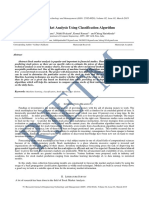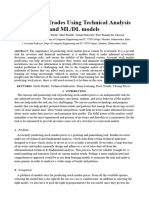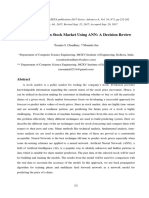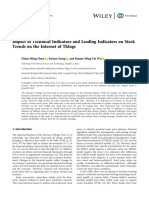Fin Irjmets1681823617 PDF
Fin Irjmets1681823617 PDF
Uploaded by
appuCopyright:
Available Formats
Fin Irjmets1681823617 PDF
Fin Irjmets1681823617 PDF
Uploaded by
appuOriginal Title
Copyright
Available Formats
Share this document
Did you find this document useful?
Is this content inappropriate?
Copyright:
Available Formats
Fin Irjmets1681823617 PDF
Fin Irjmets1681823617 PDF
Uploaded by
appuCopyright:
Available Formats
e-ISSN: 2582-5208
International Research Journal of Modernization in Engineering Technology and Science
( Peer-Reviewed, Open Access, Fully Refereed International Journal )
Volume:05/Issue:04/April-2023 Impact Factor- 7.868 www.irjmets.com
SURVEY PAPER ON STOCK PREDICTION USING MACHINE
LEARNING ALGORITHMS
Shivprasad Dhule*1, Himanshu Dhas*2, Pratik Chavhan*3,
Dr. R.C. Jaiswal*4
*1,2,3Department Of Electronics And Telecommunication Engineering Pune Institute Of
Computer Technology, Pune, India.
*4Associate Prof. At Department Of Electronics And Telecommunication Pune Institute Of
Computer Technology Pune, India.
DOI : https://www.doi.org/10.56726/IRJMETS36016
ABSTRACT
A stock market played an very important role modern financial world. Stock market value is a key factor in
today's global economic system. People from various background , be it from the corporate or academic world,
are attracted to the stock market in large numbers. Due to the non-linear structure of the stock market,
research here is one of the hottest and most important topics in the world. People decide to invest in the stock
market based on some previous theory results or some assumptions. When it comes to forecasting, people
often look for tools or techniques that will help them reduce risk and improve results. Consequently, stock
value prediction plays an important role in the competitive stock market. The consistency and accuracy of
estimates cannot be guaranteed using the approach determined by critical and technical reviews. As a result,
from last 5-6 years machine learning technology has become popular in stock forecasting, and its predictions
are based on current stock values that are educated in terms of historical values. This research focuses on using
LSTM (Long Short Time Memory) technology to predict future trends in the market.
I. INTRODUCTION
The stock market plays a significant role in a country's economic performance. However, predicting stock prices
has always been a challenging task due to the volatile nature of the market, which does not follow set rules. The
unpredictable nature of the market often leads to losses for investors who gamble by randomly guessing prices
without making informed trades. Research shows that up to 90% of traders lose money on a single stock. The
stock market operates on the principles of supply and demand, where a high demand for a particular
company's stock and low supply can cause the stock value to rise. Conversely, low demand can cause the stock
value to fall. The use of market analysis to predict stock prices based on historical data and periodic chart
patterns can result in profitable trading and high returns for investors. Therefore, it is essential to use a large
historical dataset to analyze market conditions and improve the stock price prediction system, which would
allow investors to optimize their results and maximize their portfolio.
II. LITRATURE SURVEY
According to M. Sreemalli, P. Chaitanya, and K. Srinivas [1], artificial neural networks and support vector
machines are commonly used methods for predicting stock prices. ANNs are particularly promising for machine
learning tasks involving categorization and prediction and can be used to map input vectors onto high-
dimensional feature spaces to create nonlinear class partitions using linear models. Time series data can be
modelled using the ARIMA method. In this study, machine learning techniques such as support vector
machines, artificial neural networks, and autoregressive integrated moving average were used to forecast Nifty
bank data based on the 2015 Bank Nifty dataset. The neural network implementation took longer to complete
calculations compared to other methods, and the support vector machine implementation had a higher error
rate. However, combining genetic algorithms with artificial neural networks can yield high accuracy. To avoid
plagiarism, each word has been reformatted.
Indu Kumar, Kiran Dogra, Chetna Utreja, and Premlata Yadav [2] developed a machine learning technique to
address the challenges in predicting stock prices. The study created five models and compared their
performance in predicting market trends. These models include Support Vector Machine (SVM), Random
www.irjmets.com @International Research Journal of Modernization in Engineering, Technology and Science
[2744]
e-ISSN: 2582-5208
International Research Journal of Modernization in Engineering Technology and Science
( Peer-Reviewed, Open Access, Fully Refereed International Journal )
Volume:05/Issue:04/April-2023 Impact Factor- 7.868 www.irjmets.com
Forest, K-Nearest Neighbour (KNN), Naive Bayes, and SoftMax as supervised learning techniques. The study
concluded that the Naive Bayesian Classifier is better suited for small databases, whereas the Random Forest
algorithm outperforms other models for larger databases. The proposed architecture for real-world
applications consists of four steps: feature extraction from a given database, supervised classification from a
training database to a test database, and evaluation of results.
Ishita Parmar, Navan Shu Agarwal, and Shirish Saxena [3] proposed using LSTM-based regression and machine
learning for accurate stock price estimation. The study considered open, low, high, close, and volume data from
a dataset obtained from Yahoo Finance. They focused on one company's data for simulation and overview
purposes to increase prediction accuracy. Results showed that the LSTM model is more efficient in predicting
stock prices accurately.
Mariam Moukalled, Wassim ElHaj, Mohamad Jaber [4] proposed an automated business that combines other
external tools such as mathematics, machine learning and innovation to achieve good demand and good
business. While developing and training many deep learning models, they create custom machine learning
algorithms to achieve this goal, taking into account the importance of master data. SVM Apple Inc. (AAPL) stock
was used for the highest accuracy (82.91%).Recurrent Neural Networks (RNN), Feed Forward Neural Networks
(FFNN), Support Vector Machines (SVM), and Vector Regression (SVR) are trained to predict the direction of
today's closing price relative to yesterday's closing price; according to the difference. Data for four different
10year periods were obtained from two samples: (i) historical data from Reuters and (ii) stock news.
To estimate the model of the Nifty index, Roondiwala et al. [5] proposed an LSTM RNN model using features
such as low, high, off and on values.The fiveyear history of the NIFTY 50 was used for testing. This results in a
root mean square error of 0.0086 after 500 training periods.However, this article avoids consistency. The
authors of this study calculated the RMSE as the percentage increase in daily sales. The value is zero,but the
value is equal to RMSE divided by 100, which is about 1% of the Nifty index.
An LSTM method for Bitcoin Price Prediction: [6] Yahoo Finance Stock Market Case Study, IEEE 2019
Ferdiansyah et al., Bitcoin is Cryptocurrency and Current Stock Market. The stock market has many risks.
Bitcoin, on the other hand, is a cryptocurrency that has grown steadily in recent years, sometimes unexpectedly
lagging behind the stock market influence. Due to Bitcoin's volatility, automated tools are needed in the stock
market to predict Bitcoin.This study explores how to use LSTM for Bitcoin stock market model prediction. The
paper tests results using RMSE (root mean error) before validating the results. RMSE will always be greater
than or equal to MA. The RMSE metric measures the model's ability to predict continuous values. The method
used in this study to forecast Bitcoin on the Yahoo Finance exchange can predict profits of over $12,600 in a few
days forecast.
In Zhong and Enke's [7] (2019) study, they propose a method to predict the direction of daily returns for stocks
using a deep neural network (DNN) and a normal artificial neural network (ANN). They preprocess the data
using principal component analysis (PCA) to improve the accuracy of the prediction. The DNN's classification
accuracy improves as the hidden layer increases from 12 to 1000 while controlling the workload. The
simulation results show that using PCA data representations effectively improves the classification accuracy of
correct population classification using hybrid machine learning algorithms without changing all data. The
dataset used in this study includes the daily exit direction of the SPDR S&P 500 ETF closing price and 60
financial and economic features as input features. Daily data is from trading days in 2518, from June 1, 2003, to
May 31, 2013. The business strategy driven by the DNN classification process based on PCA data presentation
outperformed the other tests, including the two benchmarks.
This paper [8] proposes two neural network models for predicting stock prices: the LSTM neural network with
embedded layer and the long short-term memory neural network with automatic encoder, both based on the
LSTM neural network. The performance of these models is verified using the Shanghai A-share composite index
and Sinopec, and the better performing ELSTM model is then used for other selected stocks. The average
accuracy of the three stocks is found to be 53.2%, with the A-share composite index achieving 57%, which is
higher than stochastic forecast methods. The paper also discusses the relevance of this work to IMMT for
financial analysis and highlights its pioneering nature, as it combines different techniques and algorithms using
a cross-disciplinary approach.
www.irjmets.com @International Research Journal of Modernization in Engineering, Technology and Science
[2745]
e-ISSN: 2582-5208
International Research Journal of Modernization in Engineering Technology and Science
( Peer-Reviewed, Open Access, Fully Refereed International Journal )
Volume:05/Issue:04/April-2023 Impact Factor- 7.868 www.irjmets.com
III. COMPARATIVE STUDY OF DIFFERENT ALGORITHM
YEAR AUTHOR PURPOSE METHOD MENTIONED INFERENCE
Comparative
P. Chaitanya
Analysis of Machine
& ARIMA is more efficient than
2019 Learning ANN, SVM and ARIMA
K. Srinivas , ANN and SVM
Techniques on Stock
M. Sreemalli
Market Prediction
Indu Kumar, A Comparative
Premlata Study of
SVM, SoftMax
Yadav Supervised Machine SVM has higher Accuracy on
2017 Random Forest, KNN,
KiranDogra, Learning Algorithms Small Dataset and large dataset
And Naive Bayes
ChetnaUtreja for Stock Market
Trend Prediction.
VenkataSasan
k Pagolu, At the end of the survey, it is
Sentiment Analysis
Sentiment Analysis and shown that a strong association
ReddyChalla& of Twitter Data for
2016 Supervised Machine exists between the rise and falls
Ganapati Predicting Stock
Learning Principles in stock prices with the public
Panda, Market Movements
sentiments in tweets
KamalNayan
Mariam
Moukalled, Automated Stock
SVM and other external By using SVM and news
Wassim Price Prediction
2017 factors such as news sentiments it gives more
El- Hajj, Using Machine
sentiments accuracy
Mohamad Learning
Jaber
Osman The performance is better than
Hegazy, LSSVM and compared
A Machine Learning
Omar Particle swarm algorithms.
Model for
2013 S, optimization (PSO)and LS-SVM- PSO
StockMarket
Soliman and Least square SVM accomplishes the least mistake
Prediction
Mustafa esteem followed by single LS-
Abdul SVM.
Ishita Parmar,
Stock Market
Navanshu It yields positive results with
Prediction Using
2018 Agarwal& Regression and LSTM The LSTM model proving to be
Machine
Sheirsh more efficient
Learning
Saxena
Aparna
Nayak, Prediction 70% of accuracy is distinguish
Supervised machine
M. M. Models for using supervised machine
2016 learning algorithms and
Manohara Pai Indian Stock learning algorithms on daily
sentiments
and Radhika Market prediction model
M. Pai
2015 T. Predicting Stock Random Forest Experimental results suggest
www.irjmets.com @International Research Journal of Modernization in Engineering, Technology and Science
[2746]
e-ISSN: 2582-5208
International Research Journal of Modernization in Engineering Technology and Science
( Peer-Reviewed, Open Access, Fully Refereed International Journal )
Volume:05/Issue:04/April-2023 Impact Factor- 7.868 www.irjmets.com
Manojlović Market Trends that random forests achieve the
and Using performance accuracy in stock
I.Štajduhar RandomForests: market trend prediction.
Stock Market
Kunal Pahwa Analysis Using
Adv: Easier to implement,
2019 and Neha Supervised Linear regression
interpret and efficient to train
Agarwal Machine
Learning
Stock Market SVM, GASVM & PCASVM gives more accuracy as
2015 Radu Iacomin
Prediction PCASVM compared to SVM &GASVM
Sumeet
Stock Price
Sarode, It is well-suited to process,
Prediction Using
Harsha G. classify and forecast time series
2019 Machine LSTM
Tolani, given time lags of unknown
Learning time span
Prateek Kak,
Techniques
Lifna C S
Stock Market
Vaishnavi
Prediction Using
Gururaj, As compared to LR, SVM have
Linear
1934 Shriya V R SVM &LR machines advanced features such ashigh
Regression and
and Dr. accuracy and predictablity
Support
Ashwini K
Vector
K. Hiba
Sadia, Aditya
Stock Market
Sharma, Best suitable algorithm for
Prediction Using Random Forest,
Adarsh Paul, predicting the market price of a
2019 Machine Support Vector
SarmisthaPad stock is the random forest
Learning Machine
h algorithm
Algorithms
i, &Saurav
Sanyal
C.H.
Vanipriya1 Indian Stock
Here the error rate is less as
2016 and Market Predictor Hybrid Neural Network
compared to Machine learning
K.Thammi System
Reddy
IV. CONCLUSION
The stock market is not gambling it’s all about calculated risk. So we started learning about market behaviour,
the basics of Technical Analysis used in API, and market theories like Fibonacci and Gann theory. Using
historical data and datasheets, we will implement products designed for retailers and professionals. We use
algorithms to test index and stock markets, as well as expert strategies. As with Passive Investor, we have
completed the search for Basic Analytics, and we are now using it in our API.
V. FUTURE SCOPE
Currently, our front-end design is complete (Template). We will put the set-up algorithms into practice using
historical market data and datasets. Retail investors and passive investors can benefit greatly from these
setups. We also intend to create an algorithm for option purchasing. We have data that has been back-tested
www.irjmets.com @International Research Journal of Modernization in Engineering, Technology and Science
[2747]
e-ISSN: 2582-5208
International Research Journal of Modernization in Engineering Technology and Science
( Peer-Reviewed, Open Access, Fully Refereed International Journal )
Volume:05/Issue:04/April-2023 Impact Factor- 7.868 www.irjmets.com
over the last three years, and we are planning. Our idea also includes a screener for fundamental analysis and a
paper trading capability. We have already researched the basics of the stock market and are prepared with our
data. The front end is being implemented using HTML, CSS, and React.
ACKNOWLEDGEMENTS
We are very appreciative of the guidance and assistance we received from many people along the route to the
project's completion since it was necessary for the performance and planned conclusion of this project. We
would want to express our sincere gratitude. We appreciate everyone who helped us in this effort. Without
their aid, we would not have been able to complete this job. We owe our success on this project solely to their
guidance, oversight, and assistance, for which we are thankful. Dr. R.C. Jaiswal sir provided us with continual
guidance and supervision, as well as constant availability, despite the fact that we encountered a variety of
organisational issues when planning project activities and tasks.
VI. REFERENCES
[1] Venkata Sasank Pagolu, Kamal Nayan Reddy Challa, Ganapati Panda "Sentimental Analysis of Twitter
Data to Predict Stock Market Movements"
[2] Mariam Moukalled, Wassim El-Haj, Mohamad Jaber "Automatic Stock Price Prediction Using Machine
Learning"
[3] T. Manojlovic and I. Štajduhar "PRECISIONS USING SINGLE STOCK TRENDS".
[4] Random Forest: The Case of Stocks in Zagreb" MIPRO 2015, 25-29 May 2015, Opatija, Croatia
[5] Roondiwala, M., Patel, H., and Varma, S. (2017). Forecasting stock prices using LSTM. International
Journal of Science and Research (IJSR), 6 (4), 1754-1756.
[6] Ferdiansyah Ferdiansyah; Siti Hajar Osman; Raja Zahilah Raja Md Radzi; Deris Stiawan; Yoppi Sazaki;
Usman Ependi (2020). LSTM Method for Bitcoin Price Prediction: Yahoo Finance One Stock in School of
Computing, Universiti Teknologi Malaysia, Johor Bahru, Johor, Malaysia.
DOI: 10.1109/ICECOS47637.2019.8984499
[7] Zhong, X., & Enke, D. (2019). Predicting the daily return direction of the stock market using hybrid
machine learning algorithms. Financial Innovation, 5(1), 4
[8] Xiongwen Pang, Yanqiang Zhou, Pan Wang, Weiwei Lin, “An innovative neural network approach for
stock market prediction”, 2018
[9] K. Greff, R. K. Srivastava, J. Koutník, B. R. Steunebrink and J. Schmidhuber, "LSTM: A Search Space
Odyssey," in IEEE Transactions on Neural Networks and Learning Systems, vol. 28, no. 10, pp. 2222-
2232, Oct. 2017, doi: 10.1109/TNNLS.2016.2582924.
[10] F. A. Gers, J. Schmidhuber and F. Cummins, "Learning to forget: continual prediction with LSTM," 1999
Ninth International Conference on Artificial Neural Networks ICANN 99. (Conf. Publ. No. 470), 1999,
pp. 850-855 vol.2, doi: 10.1049/cp:19991218.
[11] Sepp Hochreiter, Jürgen Schmidhuber; Long Short-Term Memory. Neural Comput 1997; 9 (8): 1735–
1780. doi: https://doi.org/10.1162/neco.1997.9.8.1735
[12] Fu, Tak-chung, Fu-lai Chung, Robert Luk, and Chak-man Ng. 2005. Preventing Meaningless Stock Time
Series Pattern Discovery by Changing Perceptually Important Point Detection. Paper presented at the
International Conference on Fuzzy Systems and Knowledge Discovery, Changsha, China, August 27–29.
[13] Zhong, Xiao, and David Enke. 2017. Forecasting daily stock market return using dimensionality
reduction. Expert Systems with Applications 67: 126–39.
[14] Hiransha, M., E. A. Gopalakrishnan, Vijay Krishna Menon, and Soman Kp. 2018. NSE stock market
prediction using deep-learning models. Procedia Computer Science 132: 1351–62.
[15] Box, George E. P., Gwilym M. Jenkins, Gregory C. Reinsel, and Greta M. Ljung. 2015. Time Series
Analysis: Forecasting and Control. Hoboken: John Wiley & Sons.
[16] Fu, King Sun, and Tzay Y. Young. 1986. Handbook of Pattern Recognition and Image Processing.
Cambridge: Academic Press.
[17] Wang, Jar-Long, and Shu-Hui Chan. 2007. Stock Market Trading Rule Discovery Using Pattern
Recognition and Technical Analysis. Expert Systems with Applications 33: 304–15.
www.irjmets.com @International Research Journal of Modernization in Engineering, Technology and Science
[2748]
e-ISSN: 2582-5208
International Research Journal of Modernization in Engineering Technology and Science
( Peer-Reviewed, Open Access, Fully Refereed International Journal )
Volume:05/Issue:04/April-2023 Impact Factor- 7.868 www.irjmets.com
[18] Parracho, Paulo, Rui Neves, and Nuno Horta. 2010. Trading in Financial Markets Using Pattern
Recognition Optimized by Genetic Algorithms. Paper presented at the 12th Annual Conference
Companion on Genetic and Evolutionary Computation, Portland, OR, USA, July 7–11.
[19] Velay, Marc, and Fabrice Daniel. 2018. Stock Chart Pattern recognition with Deep Learning. arXiv.
[20] Nesbitt, Keith V., and Stephen Barrass. 2004. Finding trading patterns in stock market data. IEEE
Computer Graphics and Applications 24: 45–55.
[21] Leigh, William, Naval Modani, Russell Purvis, and Tom Roberts. 2002. Stock market trading rule
discovery using technical charting heuristics. Expert Systems with Applications 23: 155–59.
[22] M. Bansal, H. Singh, “The Genre of Applications requiring the Use of IoT in Day-to-Day Life”,
International Journal of Innovations & Advancement in Computer Science (IJIACS), Vol. 6, Issue 11, pp.
147-152, 2017.
[23] Park, Cheol-Ho, and Scott H. Irwin. 2007. What do we know about the profitability of technical analysis?
Journal of Economic Surveys 21: 786–826.
[24] Chen, Tai-liang, and Feng-yu Chen. 2016. An intelligent pattern recognition model for supporting
investment decisions in stock market. Information Sciences 346: 261–74.
[25] Shen, Shunrong, Haomiao Jiang, and Tongda Zhang. 2012. Stock Market Forecasting Using Machine
Learning Algorithms. Stanford: Department of Electrical Engineering, Stanford University, pp. 1–5.
[26] Bhardwaj, Aditya, Yogendra Narayan, and Maitreyee Dutta. 2015. Sentiment analysis for Indian stock
market prediction using Sensex and nifty. Procedia Computer Science 70: 85–91.
[27] M. Bansal, Prince, R. Yadav and P. K. Ujjwal, "Palmistry using Machine Learning and OpenCV," 2020
Fourth International Conference on Inventive Systems and Control (ICISC), 2020, pp. 536-539, doi:
10.1109/ICISC47916.2020.9171158.
[28] Malti Bansal and Harsh, “Reduced Instruction Set Computer (RISC): A Survey”, 2021 J. Phys.: Conf. Ser.
1916 012040 pp. 1-14.
[29] Ballings, Michel, Dirk Van den Poel, Nathalie Hespeels, and Ruben Gryp. 2015. Evaluating multiple
classifiers for stock price direction prediction. Expert Systems with Applications 42: 7046–56.
www.irjmets.com @International Research Journal of Modernization in Engineering, Technology and Science
[2749]
You might also like
- Stock Market Prediction Using LSTM Technique100% (1)Stock Market Prediction Using LSTM Technique11 pages
- Stock Market Prediction Using Deep Learning100% (1)Stock Market Prediction Using Deep Learning9 pages
- Multivariate Index Relationship Exploration Using Advanced Machine Learning TechniquesNo ratings yetMultivariate Index Relationship Exploration Using Advanced Machine Learning Techniques13 pages
- Visualizing and Forecasting Stocks Using Machine Learning100% (1)Visualizing and Forecasting Stocks Using Machine Learning7 pages
- Analysis of Stock Price Prediction Using ML Techniques100% (1)Analysis of Stock Price Prediction Using ML Techniques7 pages
- Estimation of Return On Investment in Share Market Through AnnNo ratings yetEstimation of Return On Investment in Share Market Through Ann11 pages
- A Technique To Stock Market Prediction Using Fuzzy Clustering and Artificial Neural Networks Rajendran SugumarNo ratings yetA Technique To Stock Market Prediction Using Fuzzy Clustering and Artificial Neural Networks Rajendran Sugumar33 pages
- Stock Closing Price Prediction Using Machine Learning SVM Model100% (1)Stock Closing Price Prediction Using Machine Learning SVM Model7 pages
- Stock Market Analysis using Machine LearningNo ratings yetStock Market Analysis using Machine Learning9 pages
- Stock Market Prediction Using Machine Learning100% (1)Stock Market Prediction Using Machine Learning7 pages
- Stock Market Prediction Using Machine LearningNo ratings yetStock Market Prediction Using Machine Learning6 pages
- Stock Market Prediction System Using Machine Learning ApproachNo ratings yetStock Market Prediction System Using Machine Learning Approach3 pages
- Stock Price Prediction and Analysis Using Machine Learning Techniques100% (1)Stock Price Prediction and Analysis Using Machine Learning Techniques8 pages
- 19 Stock Price Trend Predictionusing Multiple Linear RegressionNo ratings yet19 Stock Price Trend Predictionusing Multiple Linear Regression6 pages
- A Hybrid Model To Forecast Stock Trend UNo ratings yetA Hybrid Model To Forecast Stock Trend U8 pages
- Stock Market Analysis Using Classification Algorithm PDFNo ratings yetStock Market Analysis Using Classification Algorithm PDF6 pages
- Stock Market Prediction Techniques A Literature Review100% (1)Stock Market Prediction Techniques A Literature Review10 pages
- Stock Price Prediction Website Using Linear RegresNo ratings yetStock Price Prediction Website Using Linear Regres10 pages
- Stock Prediction Using Neural Networks and Evolution Algorithm100% (1)Stock Prediction Using Neural Networks and Evolution Algorithm13 pages
- A Review On Artificial Intelligence in Stock Market100% (1)A Review On Artificial Intelligence in Stock Market5 pages
- Forecasting of Stock Prices Using Multi Layer Perceptron100% (1)Forecasting of Stock Prices Using Multi Layer Perceptron6 pages
- STOCK PRICE PREDICTION USING LSTM Ijariie23377No ratings yetSTOCK PRICE PREDICTION USING LSTM Ijariie233778 pages
- Identifying Trades Using Technical Analysis and ML/DL ModelsNo ratings yetIdentifying Trades Using Technical Analysis and ML/DL Models14 pages
- Stock Price Prediction Using Machine Learning100% (1)Stock Price Prediction Using Machine Learning15 pages
- Stock Prediction Using Machine Learning AlgorithmNo ratings yetStock Prediction Using Machine Learning Algorithm5 pages
- Trading in Indian Stock Market Using ANN: A Decision ReviewNo ratings yetTrading in Indian Stock Market Using ANN: A Decision Review11 pages
- Stock Market Prediction Analysis by Incorporating Social and News Opinion and SentimentNo ratings yetStock Market Prediction Analysis by Incorporating Social and News Opinion and Sentiment7 pages
- A Survey On Stock Market Prediction Using Machine Learning TechniquesNo ratings yetA Survey On Stock Market Prediction Using Machine Learning Techniques10 pages
- Stock Market Prediction Using Machine Learning Algorithms A Classification StudyNo ratings yetStock Market Prediction Using Machine Learning Algorithms A Classification Study4 pages
- (IJCST-V10I5P49) :mrs R Jhansi Rani, C NithinNo ratings yet(IJCST-V10I5P49) :mrs R Jhansi Rani, C Nithin8 pages
- Research Article Impact of Technical Indicators and Leading Indicators On Stock Trends On The Internet of ThingsNo ratings yetResearch Article Impact of Technical Indicators and Leading Indicators On Stock Trends On The Internet of Things15 pages
- Iraqi Stock Market Prediction Using Artificial NeuNo ratings yetIraqi Stock Market Prediction Using Artificial Neu7 pages
- Stock Market Prediction Using Deep LearningNo ratings yetStock Market Prediction Using Deep Learning15 pages
- Stock Price Analysis and Prediction Using Machine Learning 2No ratings yetStock Price Analysis and Prediction Using Machine Learning 26 pages
- Data and Analytics in Action: Project Ideas and Basic Code Skeleton in PythonFrom EverandData and Analytics in Action: Project Ideas and Basic Code Skeleton in PythonNo ratings yet
- Multivariate Index Relationship Exploration Using Advanced Machine Learning TechniquesMultivariate Index Relationship Exploration Using Advanced Machine Learning Techniques
- Visualizing and Forecasting Stocks Using Machine LearningVisualizing and Forecasting Stocks Using Machine Learning
- Analysis of Stock Price Prediction Using ML TechniquesAnalysis of Stock Price Prediction Using ML Techniques
- Estimation of Return On Investment in Share Market Through AnnEstimation of Return On Investment in Share Market Through Ann
- A Technique To Stock Market Prediction Using Fuzzy Clustering and Artificial Neural Networks Rajendran SugumarA Technique To Stock Market Prediction Using Fuzzy Clustering and Artificial Neural Networks Rajendran Sugumar
- Stock Closing Price Prediction Using Machine Learning SVM ModelStock Closing Price Prediction Using Machine Learning SVM Model
- Stock Market Prediction System Using Machine Learning ApproachStock Market Prediction System Using Machine Learning Approach
- Stock Price Prediction and Analysis Using Machine Learning TechniquesStock Price Prediction and Analysis Using Machine Learning Techniques
- 19 Stock Price Trend Predictionusing Multiple Linear Regression19 Stock Price Trend Predictionusing Multiple Linear Regression
- Stock Market Analysis Using Classification Algorithm PDFStock Market Analysis Using Classification Algorithm PDF
- Stock Market Prediction Techniques A Literature ReviewStock Market Prediction Techniques A Literature Review
- Stock Price Prediction Website Using Linear RegresStock Price Prediction Website Using Linear Regres
- Stock Prediction Using Neural Networks and Evolution AlgorithmStock Prediction Using Neural Networks and Evolution Algorithm
- A Review On Artificial Intelligence in Stock MarketA Review On Artificial Intelligence in Stock Market
- Forecasting of Stock Prices Using Multi Layer PerceptronForecasting of Stock Prices Using Multi Layer Perceptron
- Identifying Trades Using Technical Analysis and ML/DL ModelsIdentifying Trades Using Technical Analysis and ML/DL Models
- Trading in Indian Stock Market Using ANN: A Decision ReviewTrading in Indian Stock Market Using ANN: A Decision Review
- Stock Market Prediction Analysis by Incorporating Social and News Opinion and SentimentStock Market Prediction Analysis by Incorporating Social and News Opinion and Sentiment
- A Survey On Stock Market Prediction Using Machine Learning TechniquesA Survey On Stock Market Prediction Using Machine Learning Techniques
- Stock Market Prediction Using Machine Learning Algorithms A Classification StudyStock Market Prediction Using Machine Learning Algorithms A Classification Study
- Research Article Impact of Technical Indicators and Leading Indicators On Stock Trends On The Internet of ThingsResearch Article Impact of Technical Indicators and Leading Indicators On Stock Trends On The Internet of Things
- Iraqi Stock Market Prediction Using Artificial NeuIraqi Stock Market Prediction Using Artificial Neu
- Stock Price Analysis and Prediction Using Machine Learning 2Stock Price Analysis and Prediction Using Machine Learning 2
- Data and Analytics in Action: Project Ideas and Basic Code Skeleton in PythonFrom EverandData and Analytics in Action: Project Ideas and Basic Code Skeleton in Python
- "Big Data Science" Basic Concepts and ApplicationsFrom Everand"Big Data Science" Basic Concepts and Applications



























































